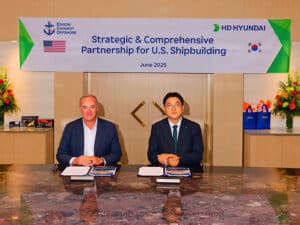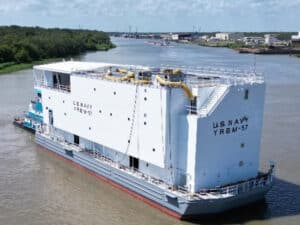
Great Lakes Dredge splashes out at U.S. shipyards
Written by Nick Blenkey AUGUST 3, 2012 — Great Lakes Dredge & Dock Corporation (NASDAQ: GLDD) has signed a contract with shipbuilder Signal International, Inc. for the construction of a 15,000-cubic-yard-capacity trailing suction hopper barge and 14,000-horsepower tug. Together, the two units will function as an articulated tug and barge (“ATB”) trailing suction hopper dredge that will be the largest hopper dredge in the United States.
AUGUST 3, 2012 — Great Lakes Dredge & Dock Corporation (NASDAQ: GLDD) has signed a contract with shipbuilder Signal International, Inc. for the construction of a 15,000-cubic-yard-capacity trailing suction hopper barge and 14,000-horsepower tug. Together, the two units will function as an articulated tug and barge (“ATB”) trailing suction hopper dredge that will be the largest hopper dredge in the United States.
Great Lakes has also contracted with BAE Systems in Mobile, Alabama to build two new high-capacity material dump scows for delivery in 2013 with an option to build two additional units also with delivery in 2013. The scows will be used primarily on capital deepening and coastal restoration work on the East and Gulf coasts. These two new scows, with an aggregate cost of approximately $17 million, will each have a carrying capacity of 7,700 cubic yards of dredged material.
Signal International will perform the detail design and construct the ATB dredge in Orange, Texas, based on a patent pending engineered design and performance specification provided by Great Lakes. The aggregate cost of the initial dredge is expected to be approximately $94 million.
Great Lakes’ patent pending design for the dredge introduces a new concept for hopper dredging in both deep and shallow waters, providing extensive flexibility.
The new dredge, with a hopper capacity of 15,000 cubic yards, applies well-known and proven ATB technology to hopper dredging. Great Lakes says this enables it to “continue its leadership in the dredging industry as the low cost provider.”
The dredge will feature two 36-inch suction pipes and will be able to dredge at depths of up to 125 feet. Even with a maximum load it will only have a draft of 28 feet, the best carrying-capacity-to-draft ratio in the U.S. dredging industry. The new dredge will be well-suited to multi-use applications. It will be deployed for channel deepening, maintenance dredging, beach nourishment, and coastal restoration projects with long distance transport capabilities.
The tug and barge hull form design was optimized at MARIN in the Netherlands.
The vessel features a proven Articouple interconnect system for the tug and barge. Its high-tech ATB design includes all of the latest innovations and developments in dredging technology.
MARIN’s Senior Project Manager Klaas Kooiker said, “Having modeled and tested many of the world’s modern hopper dredge hull forms, we were very pleased to see the Great Lakes ATB hull achieve similar speed and power results. We believe this is the first ATB hull to equal ship performance capabilities.”
The ATB will be equipped with a direct high power pump-ashore installation, a hybrid power sharing configuration between the tug and barge, dynamic positioning and tracking, EPA Tier III compliant engines, and additional features designed to minimize the impact of its dredging process on the environment.
Great Lakes President of Dredging Operations Dave Simonelli said, “We have ownership and operating experience with tug-barge dredge combinations that dates back 40 years. ATB and hopper dredge technology have advanced greatly during that time. I am pleased that our in-house engineering team working in close cooperation with Offshore Tug and Barge Corporation were able to design a proprietary unit, for which a patent is pending, that will be able to achieve ship-like productivity and efficiency at an ATB’s lower operating cost. Our dredge is a ‘game changer’ in the competitive hopper dredging marketplace and will bring important new capacity to the U.S. hopper dredge fleet. The favorable environmental and safety features of the design, including greater fuel efficiency, green overflow systems and automated processes, were important considerations. These features emphasize our focus on minimizing the impact of dredging on the environment and providing a safe work environment for our employees.”
The recently enacted RESTORE act provides for funding to ensure the important Gulf Coast coastal and barrier island restoration is performed as expeditiously as possible. The Great Lakes dredge will be a key tool in performing the restoration of the eroded land mass in the Gulf Coast States. Additionally, the vessel’s ability to cost-effectively deepen and maintain navigable waterways will bolster the United States’ competitive position in world trade, as U.S. ports move forward with deepening plans to accommodate the larger vessels, which will sail through the expanded Panama Canal to be completed in 2015.
Great Lakes Chief Executive Officer Jon Berger said, “We are very excited about this investment in new equipment. As we analyze the future dredging market, U.S. Shipyard capability and the cost of capital, we feel the time is right for these new builds. In addition, the building of the ATB Hopper Dredge and two scows will add more than 250 jobs in the two shipyards. We were attracted to the favorable construction and operating cost economics of the dredge for the market growth ahead, underscoring our belief in the dredging market and commitment to innovation in our core business. We expect this unique hopper dredge to offer new economics to our customers in the domestic market, and possibly beyond. The investment in the two new high capacity material scows will further ready us for the worldwide market growth ahead. We have invested significant engineering effort into the proprietary, patent pending design of the hopper dredge for the future and believe our customers will be very pleased with the capability we are adding to the market. Great Lakes enjoys a legacy of superior innovation, engineering and execution, and this is a continuation of those attributes and our commitment to the dredging industry.”
ATB DREDGE

DUMP SCOW




![NOAA Ship Oscar Dyson working in the Bering Sea in Alaska. [Photo: NOAA Marine and Aviation Operations/CDR Carl Rhodes]](https://www.marinelog.com/wp-content/uploads/2025/06/blobid1_1750193597078-300x225.jpg)

Leave a Reply
You must be logged in to post a comment.